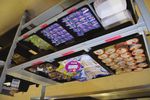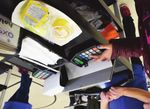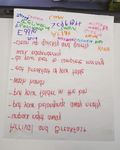School Breakfast Expansion MINI TOOLKIT - FOR SCHOOL REOPENING FALL 2020 - Rhode Island Healthy Schools Coalition
←
→
Page content transcription
If your browser does not render page correctly, please read the page content below
School Breakfast Expansion MINI TOOLKIT
FOR SCHOOL REOPENING FALL 2020
School Breakfast in the time of COVID-19
Rhode Island, along with the nation and the world, has had to reexamine priorities
and make huge adjustments to everyday life in the face of the COVID-19
pandemic. Schools in particular continue to be central to addressing overall
child/adolescent development by providing essential academic instruction, safe care, mental and
social-emotional health supports, opportunities for physical activity, and reliable nutrition.
And though RI schools are planning to reopen for the 2020-2021 school year, school meal programs will need to
change to conform to social distancing guidelines, adapt to multiple modes of service and scheduling, and support
optimal participation in the program.
This mini toolkit will help Rhode Island schools consider innovative ways to reimagine the School Breakfast
Program by adopting alternative service models and better engaging with stakeholders so more students can
start their day of learning with the fuel of good nutrition.
School Breakfast = Big Impact
All kids deserve a healthy start, as well as a healthy future, and schools play a critical role in providing an
environment for them to learn, grow and thrive. The simple act of feeding kids a healthy school breakfast can
generate positive, large-scale outcomes in education, health and economics. But school breakfast programs
remain underutilized and many students lack access to something so simple yet so important for them to fully
reach their potential.
Hunger in Rhode Island: School Breakfast Can Help
Ensuring equitable access for all students to school breakfast has many proven benefits. But it is especially
important for children who struggle with hunger and its devastating impacts. Hunger and food insecurity are
linked to serious physical, behavioral, social and cognitive difficulties in children. The USDA defines food insecurity
as the lack of consistent access to enough food for an active, healthy life. Between 2016 and 2018, 11.0% of Rhode
Island households were food insecure.
Federal meal programs, including the School Breakfast Program (SBP), play a key role in alleviating food insecurity,
improving dietary intake, and supporting the well-being and academic achievement of children.
Rhode Island School Breakfast Participation
Currently in RI, only 23 % of students enrolled in public schools access the School Breakfast Program.
Just over two in four students But fewer than one in four
enrolled in RI public schools students enrolled in RI public
participate in the National schools participate in the
School Lunch Program School Breakfast ProgramWhy is Breakfast Participation so low?
Lack of awareness about the School Breakfast Program and drawbacks of the traditional model of serving
breakfast in the cafeteria before the start of the school day have contributed to low participation:
LACK OF TIME PERCEIVED STIGMA
Students are unable to get to Students want to avoid the
school early; buses often don’t long-held stigma of eating in
arrive on time the cafeteria
LACK OF HUNGER LOSS OF SOCIAL TIME
Students may not be hungry Students choose socializing
before school, especially or playing over eating in the
secondary students who often cafeteria, away from their
start school VERY early friends
The new COVID-19 environment, with a strong focus on health, safety and equity, along with staggered scheduling
and reconceived service and dining spaces, may actually create opportunities for using creative and proven
strategies to make breakfast even more accessible and attractive to a greater number of students and families.
Breakfast After the Bell: Incorporating Breakfast into the School Day
Offering alternative breakfast options AFTER THE BELL, incorporated into the school day, may make a good deal of
sense at the start of the new school year. Breakfast After the Bell can be structured in one of three ways, or a hybrid
version, depending on a school’s preference and capabilities, with consideration of kitchen/serving equipment,
logistics, staffing needs and available dining spaces.
BREAKFAST IN THE CLASSROOM
Students eat together in the classroom at the start of the school day, after the morning
bell. Breakfasts are delivered by students or staff to classrooms from the cafeteria via
coolers or insulated rolling bags and students eat while teachers take attendance, collect
homework or teach short lesson plans so no instructional time is lost.
GRAB & GO BREAKFAST
Conveniently packaged breakfasts are available to students from mobile carts located in
high traffic locations such as school entrances, hallways or outside of the cafeteria.
Students can eat in their classroom or in a common area before and after the bell has
rung. Strategically placed trash cans allow students to eat when and where they can,
within school guidelines.
e SECOND CHANCE BREAKFAST
nc Br
ha e Students eat breakfast during a break in the morning, often between first and second
C
ak
period or midway between breakfast and lunch. Schools can serve breakfast using a
Second
fast
Grab & Go model, or they can open the cafeteria to serve breakfast during the break.
Second Chance Breakfast can be effective for middle or high school students who may
not be hungry first thing in the morning.Breakfast in the Classroom Grab & Go Breakfast Second Chance Breakfast
Between 1st & 2nd period or
BEFORE the 1st bell OR
A�er the 1st bell, usually during following homeroom during
When AFTER the 1st bell, during nutri�on
the first 10 -15 minutes of class passing period (op�mally
break or passing period
scheduled two hours before lunch)
Serving cart(s) and/or reimbursable
meal vending machines in high Cafeteria OR
Service foot-traffic areas (e.g. hallways, bus Cart(s) or reimbursable meal
Classroom
Location drop-off, school entrances) vending machines in high foot-
Serving cart(s) in cafeteria to open up traffic areas (e.g. hallways)
more serving lines
On the way to class On the way to class
Dining
Classroom In a classroom In a classroom
Location
In designated ea�ng areas In designated ea�ng areas
Food Service staff pack breakfasts in
Food Service staff pack breakfasts in
insulated containers
bags or arrange items on service carts Depending on service loca�on:
Designated students bring containers
located strategically around campus
to classrooms
Items are usually hand-held and Similar to tradi�onal breakfast OR
How In 10 -15 minutes, students serve,
portable (e.g., no utensils required) Similar to Grab & Go from cart(s) or
eat, and clear breakfast
Point of Service (POS) systems o�en reimbursable meal vending
During breakfast, teachers conduct machines around campus
used to expediate service and ensure
morning ac�vi�es and can integrate
proper meal coun�ng
simple nutri�on lessons
Serves students who can’t get to
Reduces s�gma by moving breakfast school early due to bus or family
Usually highest par�cipa�on of all out of the cafeteria schedules
breakfast models (upwards of 70%) Serves students who are short on �me Serves students who are not
Decreases s�gma before school or between classes hungry before school but are
Impact
Students serve and clear breakfast Helpful for schools with limited hungry before lunch and o�en visit
Teachers record which/how many cafeteria serving/sea�ng capacity the nurse with physical complaints
students take reimbursable breakfast Eliminates USDA meal pa�ern and Par�cularly helpful for schools with
USDA meal pa�ern and claiming claiming training requirement for early start �me and/or late lunch
training requirement for teachers teachers periods
POS keypads connected to student POS keypads connected to student
accounts allows for smooth and accounts allows for smooth and
Support from teachers, custodians, efficient service, as well as for accurate efficient service, as well as for
and administrators is essen�al repor�ng of claims. accurate repor�ng of claims.
Keys to Well suited for high free/reduced Though�ul waste management plan Bell schedule and school policy
Success meal schools where all students eat
Adequate number of service cart(s) or allows for mid-morning breakfast
free of charge
reimbursable meal vending machines
More common in elementary schools Though�ul student supervision plan
and effec�ve placement
Adequate number/size of service
Can be used effec�vely in
and dining loca�ons
elementary, middle and high schools
Most effec�ve in secondary schoolsWoonsocket made a commitment to
better breakfast access for all students
and completed an assessment to
determine the needs and feasibility to
make it happen. With perseverance and
the willingness to try new things, they
ended up with a hybrid model that meets
the unique needs of each of their schools.
Some elementary schools implemented
Breakfast in the Classroom. The Middle
Schools brought in mobile carts with POS (point of service) tablets in hallways to serve Grab & Go meals. But other
elementary schools improved the function of their cafeteria by using two mobile carts right inside the café door to
create multiple serving lines with grab & go options that allow more kids to quickly get a meal and eat in the
cafeteria or the classroom.
Providence school breakfast menus and meal claiming oversight can In this classroom at
improve due to some helpful student-centered feedback and the Hennessey Elementary
development of a more efficient reporting strategy. A classroom teacher, School in East Providence,
the district wellness coordinator, district food service staff, and registered students sign a “contract”
dieticians with URI SNAP-Ed met (pre-COVID) to review the Breakfast in outlining their routine and
the Classroom program. Student survey preferences, nutritional responsibilities for the
guidance, and operational considerations were addressed. The outcomes Breakfast in the Classroom
were an improved menu with less sugar, more protein, a greater diversity program. Expectations are
of fresh fruits and less packaged items, as well as the development of a clearly outlined (including
new Google Doc system to include both student attendance and cleanup), and breakfast
breakfast meal counts to lessen the burden on classroom teachers. proceeds smoothly and
successfully!
RESOURCES
COVID-19 (Share Our Strength No Kid Hungry Center for Best Practices) Continually updated resources to help
program sponsors, community partners, and advocates provide meals to children as a result of the coronavirus.
Back-to-School Meal Service Toolkit 2020-2021 (Share Our Strength No Kid Hungry Center for Best Practices)
Toolkit designed to help schools and districts plan plan for the 2020-2021 school year, as we continue to navigate
the coronavirus pandemic.
SNA COVID-19 Thought Starters on Reopening Schools (School Nutrition Association) The School Nutrition
Association has prepared a helpful document offering guidance to food service operators (and other school
administrators and staff tasked with preparing for school re-openings) on the myriad of operational and
administrative considerations that must be addressed for school year 2020-21, including ideas on procurement,
menu, serving, staffing, training and financial implications for multiple modes of meal service. Interspersed
throughout are “thought starters” and “tips”; creative ideas and probing questions to help with the who, what,
when, where, and how of these complex preparations.
This mini toolkit was developed by RI Healthy Schools Coalition, in conjunction with
the Rhode Island Department of Education. July 2020You can also read

























































